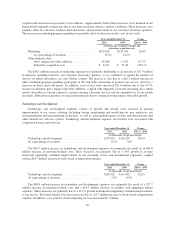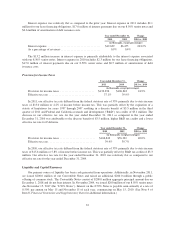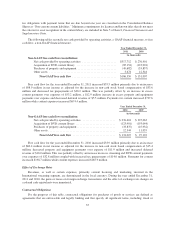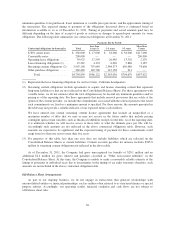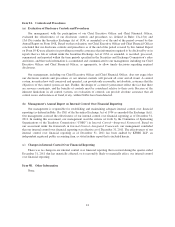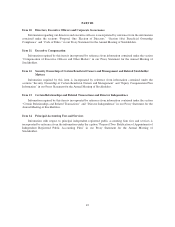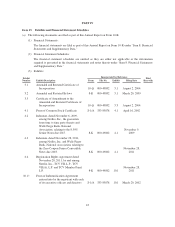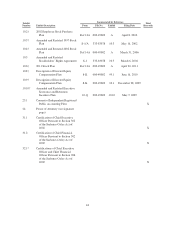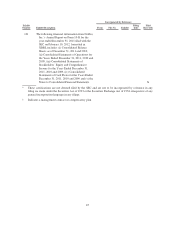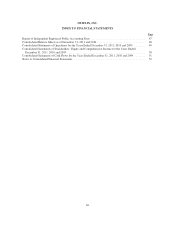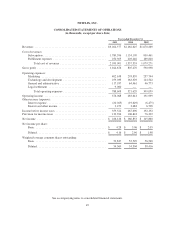NetFlix 2011 Annual Report Download - page 41
Download and view the complete annual report
Please find page 41 of the 2011 NetFlix annual report below. You can navigate through the pages in the report by either clicking on the pages listed below, or by using the keyword search tool below to find specific information within the annual report.therefore, can reasonably be expected to be a better indicator of expected volatility than historical
volatility of our common stock. We include the historical volatility in our computation due to low trade
volume of our tradable forward call options in certain periods thereby precluding sole reliance on implied
volatility. An increase of 10% in our computation of expected volatility would increase the total stock-
based compensation expense by approximately $3.1 million.
•Suboptimal Exercise Factor: Our computation of the suboptimal exercise factor is based on historical
option exercise behavior and the terms and vesting periods of the options granted and is determined for
both executives and non-executives. An increase in the suboptimal exercise factor of 10% would increase
the total stock-based compensation expense by approximately $2.3 million.
Income Taxes
We record a provision for income taxes for the anticipated tax consequences of our reported results of
operations using the asset and liability method. Deferred income taxes are recognized by applying enacted
statutory tax rates applicable to future years to differences between the financial statement carrying amounts of
existing assets and liabilities and their respective tax bases as well as net operating loss and tax credit
carryforwards. The effect on deferred tax assets and liabilities of a change in tax rates is recognized in income in
the period that includes the enactment date. The measurement of deferred tax assets is reduced, if necessary, by a
valuation allowance for any tax benefits for which future realization is uncertain.
Although we believe our assumptions, judgments and estimates are reasonable, changes in tax laws or our
interpretation of tax laws and the resolution of any tax audits could significantly impact the amounts provided for
income taxes in our consolidated financial statements.
In evaluating our ability to recover our deferred tax assets, in full or in part, we consider all available
positive and negative evidence, including our past operating results, and our forecast of future earnings, future
taxable income and prudent and feasible tax planning strategies. The assumptions utilized in determining future
taxable income require significant judgment and are consistent with the plans and estimates we are using to
manage the underlying businesses. Actual operating results in future years could differ from our current
assumptions, judgments and estimates. However, we believe that it is more likely than not that substantially all
deferred tax assets recorded on our Consolidated Balance Sheets will ultimately be realized. In the event we were
to determine that we would not be able to realize all or part of our net deferred tax assets in the future, an
adjustment to the deferred tax assets would be charged to earnings in the period in which we make such
determination.
We did not recognize certain tax benefits from uncertain tax positions within the provision for income taxes.
We may recognize a tax benefit only if it is more likely than not the tax position will be sustained on examination
by the taxing authorities, based on the technical merits of the position. The tax benefits recognized in the
financial statements from such positions are then measured based on the largest benefit that has a greater than
50% likelihood of being realized upon settlement. At December 31, 2011, our estimated gross unrecognized tax
benefits were $28.1 million of which $22.4 million, if recognized, would favorably impact our future earnings.
Due to uncertainties in any tax audit outcome, our estimates of the ultimate settlement of our unrecognized tax
positions may change and the actual tax benefits may differ significantly from the estimates. See Note 8 of
Item 8, Financial Statements and Supplementary Data for further information regarding income taxes.
Item 7A. Quantitative and Qualitative Disclosures about Market Risk
The primary objective of our investment activities is to preserve principal, while at the same time
maximizing income we receive from investments without significantly increased risk. To achieve this objective,
we follow an established investment policy and set of guidelines to monitor and help mitigate our exposure to
interest rate and credit risk. The policy sets forth credit quality standards and limits our exposure to any one
issuer, as well as our maximum exposure to various asset classes. We maintain a portfolio of cash equivalents
39



